Ask Ethan: could we reach the speed of light by Christmas?
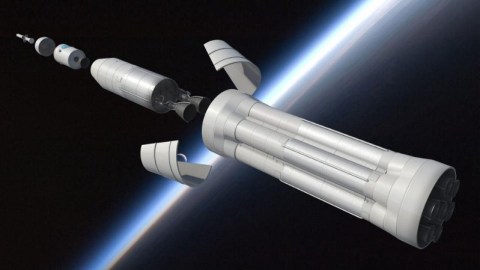
If we left on New Years Day, how close could we get if we kept accelerating every second of every day?
“The very closest stars would require many years to visit, even traveling at the speed of light, which is impossible according to Einstein’s theory of relativity. Today’s fastest spaceships would require 200,000 years to travel to Alpha Centauri, our closest bright star. The energy required to send a hundred colonists to another star, as Frank Drake has pointed out, would be enough to meet the energy needs of the entire United States over a human lifetime. And these estimates are regarding nearby stars. When we consider the distances across the entire galaxy, and between galaxies, interstellar travel seems absolutely untenable.” –David E. Fisher
So, you want to head on an interstellar voyager, and reach your destination as quickly as possible. You might not have a chance of getting there by this Christmas, but if you had the right tools and technology — and got a little help from Einstein’s relativity — could you get there by next Christmas? And what about reaching the speed of light? That’s what this week’s Ask Ethan is about, courtesy of Blair Ribeca, who inquires:
In a book I read recently the author tried to explain Einstein’s twin paradox by imagining a space ship accelerating at one “g” for 20 years then returning […] is it actually possible to accelerate at one g for any thing like twenty years? Doing the math, if one starts out at New Year’s Day and accelerates at 32 feet per second per second one would attain light speed before Christmas. How would one continue to accelerate beyond that?
For a journey to the stars, accelerating like this is absolutely essential.
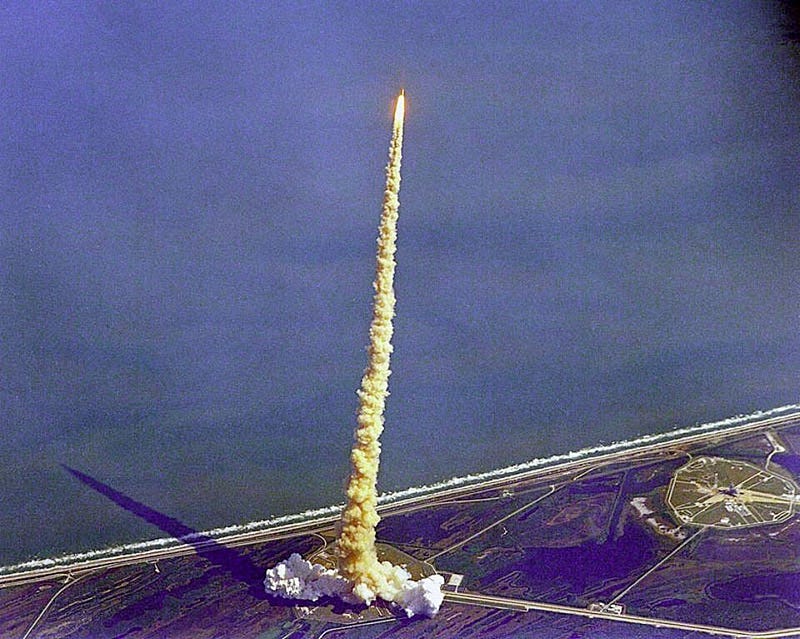
The most advanced rockets and propulsion systems every created by humanity aren’t super powerful because they accelerate something so quickly; they’re impressive because they accelerate such a large mass for such a long period of time. The accelerations that rockets like Saturn V, Atlas, Falcon and Soyuz achieve are no better than a standard sportscar: between 1 and 2 gs of acceleration, where a g is 9.8 meters per second per second. The big difference between a rocket and a sportscar? A top-of-the-line sportscar will top out after about 9 seconds of acceleration, where it’s reached a speed of around 320 km/hr (200 mph). But a rocket can accelerate at that same rate for much longer: not just seconds or minutes, but for a quarter of an hour.

That’s how we can overcome Earth’s gravitational pull and go into orbit, reach other worlds in our Solar System or even leave our Sun’s gravitational pull altogether. But at some point, we reach our limits, too: we can only accelerate for so long because of the amount of fuel we can carry. The rocket fuel we use is, unfortunately, incredibly inefficient. You’ve likely seen Einstein’s most famous equation: E = mc², which talks about how mass is a form of energy, and that energy can be stored in the form of matter. Our rocket fuel, as wonderful as it is, is woefully inefficient.

Making use of chemical reactions, it convert a maximum of 0.001% of that mass into energy, severely limiting the top speeds a spacecraft can reach. This is also why it takes a rocket of over 500 tons in mass to simply launch a 5 ton payload into a geostationary orbit. Nuclear rockets would be much more efficient, converting perhaps 0.5% of their mass into energy, but the ultimate dream would be matter-antimatter fuel, which could make the E = mc² conversion 100% efficient. If you had a rocket that was of a given mass — no matter what that mass was — and just 5% of that mass were antimatter (with another 5% of disposable matter), you could control the annihilations over time. The result would be a steady, constant acceleration of 1 g for far longer than any other fuel source would give you.
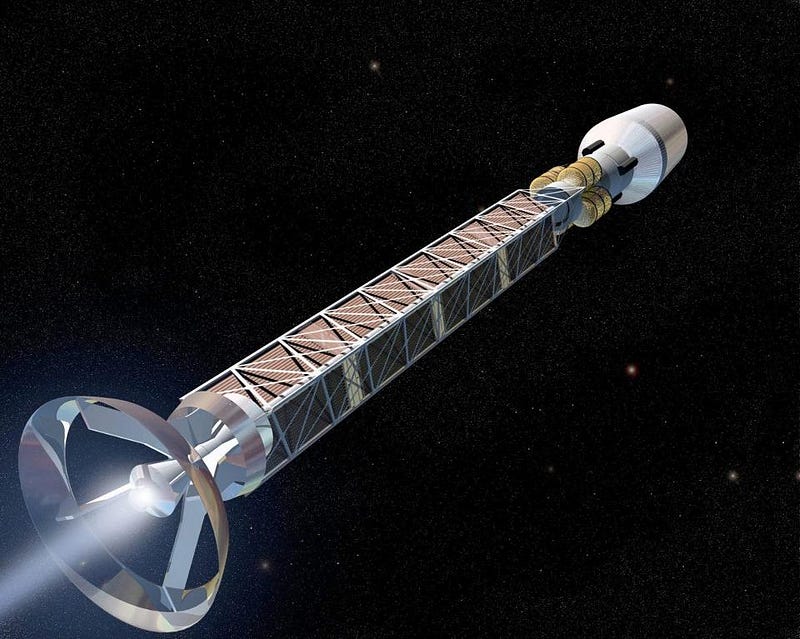
If you demand an acceleration that’s constant, matter-antimatter annihilation that’s a few percent of your total mass will enable you to accelerate for a few months at that rate. You can get up to approximately 40% the speed of light in this fashion, meaning if you used the entire annual energy budget of the United States from all sources to create antimatter, you could accelerate about a 100 kg probe to this speed. If you want to accelerate for longer than a few months, however, you need to start increasing the amount of fuel you take with you. Moreover, the more you accelerate — the closer you get to the speed of light — the more you’ll start to notice the effects of special relativity.
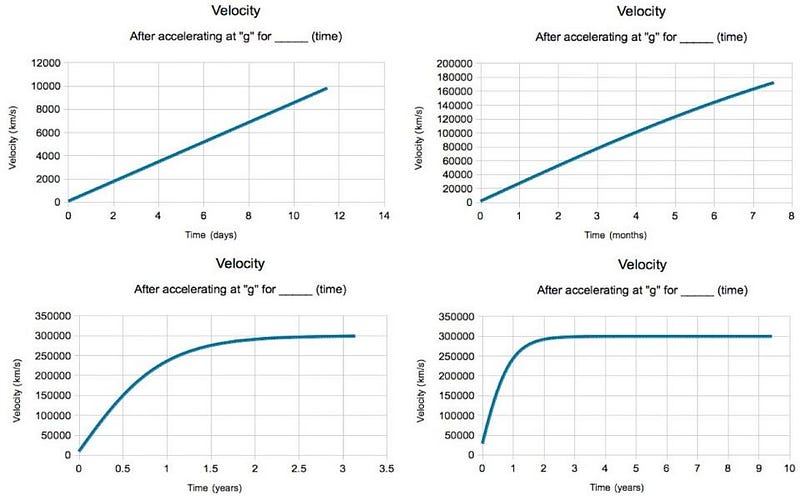
After 10 days of accelerating at 1 g, you’ll pass by Neptune, the last planet in our Solar System. After a few months, you’ll start to notice time dilating and lengths contracting, even as you continue to accelerate. By time a year goes by, you’ll hit 80% the speed of light; by time 2 years goes by, you’re at 98% the speed of light; after 5 years of 1 g acceleration, you’ll hit 99.99% the speed of light. And the longer you continue to accelerate, the closer to the speed of light you’ll get. But you’ll never, ever reach it. And more importantly, it costs you more energy as time goes on.
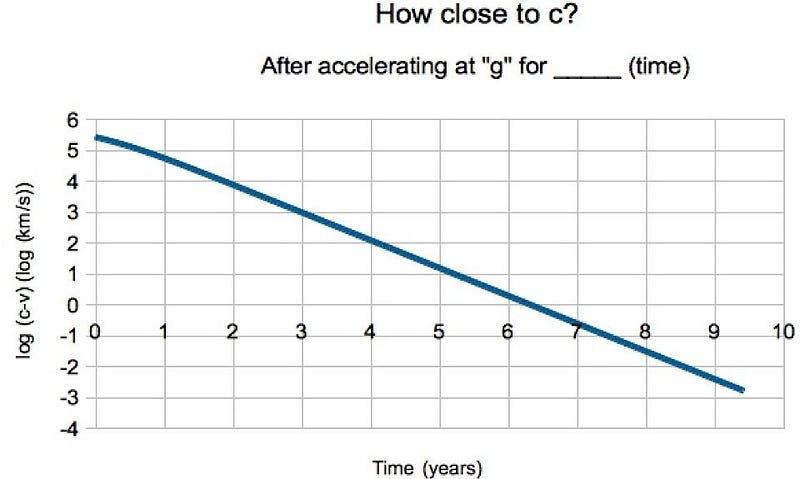
The first ten minutes of acceleration takes a certain amount of energy, and by the end of it, you’re moving at about 6 km/s. The second ten minutes, however, will get you up to double the speed at 12 km/s, but takes three times as much energy. The next ten minutes will get you up to 18 km/s, but uses up five times as much energy as the first ten minutes. And this pattern continues. By time a year has gone by, you’re using over 100,000 times the amount of energy you started out using, and you’re still using it every ten minutes! Not only that, but you’re not even increasing your velocity by the same amount; your attempts to change your speed get progressively less and less effective.

If you wanted to accelerate a 100 kg spaceship at 1 g for a year, you’d need about 1000 kg of matter and 1000 kg of antimatter to get there. By next Christmas, you’ll be moving at 80% the speed of light, but you’ll never exceed it. Not even with an infinite amount of energy. Accelerating at a constant rate takes more and more thrust, and as you continue to go faster, more and more of your energy goes into the relativistic effects, not into extra speed. Until we figure out the secret to controlling the deformation of space, the speed of light truly is the ultimate limit of the Universe. Anything with a mass can never reach it, much less exceed it. But if you started today, by next Christmas you’d come closer than any macroscopic object has ever gone!

Send in your questions and suggestions to startswithabang at gmail dot com!
This post first appeared at Forbes, and is brought to you ad-free by our Patreon supporters. Comment on our forum, & buy our first book: Beyond The Galaxy!





